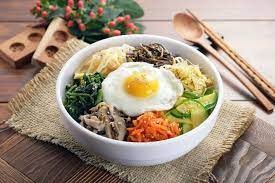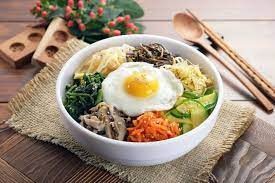Korean cuisine is a treasure trove of flavors, and one dish that has captured the hearts and taste buds of people worldwide is Bibimbap (비빔밥). With its vibrant colors, diverse ingredients, and harmonious flavors, Bibimbap is not just a meal; it’s a culinary adventure. In this Blog Post, we will delve into the history, various types, benefits, storage, recipes, ingredients, nutrition, FAQs, and more about this beloved Korean dish.
History of Bibimbap (비빔밥)
Bibimbap (비빔밥), one of Korea’s most iconic dishes, has a history that spans centuries and reflects the country’s cultural and culinary evolution. This beloved dish is not only a testament to Korea’s gastronomic heritage but also a symbol of its resilience and adaptability. The dish evolved over time and became popular as a nutritious and visually appealing meal.

The Roots of Bibimbap
The origins of Bibimbap can be traced back to the early days of Korean cuisine. In ancient Korea, rice was a staple food, and various grains and vegetables were cultivated in abundance. These ingredients formed the foundation of Bibimbap as we know it today.
Read Also: Creative Ways to Use Leftovers
Bibimbap in Korean Royal Court Cuisine
During the Joseon Dynasty (1392-1910), Bibimbap gained prominence and evolved into a sophisticated dish. It became a favorite in the royal court cuisine, known for its emphasis on aesthetics and balance in both flavor and presentation.
In the royal court, Bibimbap was meticulously prepared, with each ingredient carefully selected and arranged to create a visually stunning and delicious masterpiece. Royal chefs used vibrant, seasonal vegetables and top-quality meat to craft Bibimbap fit for royalty. These culinary artisans created various types of Bibimbap, each with its own unique flavor profile and ingredients.
Bibimbap as a Symbol of Balance
The name “Bibimbap” itself reflects the essence of the dish. “Bibim” means “mix” or “stir,” while “bap” means “rice.” The act of mixing the ingredients with rice symbolizes balance and harmony, a concept deeply ingrained in Korean culture. This balance extends to the use of the five traditional colors in Bibimbap, representing the five elements: red for fire, yellow for earth, green for wood, black for water, and white for metal.
Bibimbap in Modern Times
In the 20th century, Bibimbap underwent a transformation from a royal court delicacy to a beloved everyday meal in Korea and eventually gained international recognition. The dish’s accessibility and adaptability have contributed to its widespread popularity. Today, Bibimbap is enjoyed not only in Korea but also in Korean restaurants worldwide.
Recommended: How to use Leftover Mashed Potatoes
Various Types of Bibimbap (비빔밥)
1. Dolsot Bibimbap (돌솥 비빔밥)
Dolsot Bibimbap is perhaps the most well-known variation of Bibimbap. Served in a sizzling hot stone pot, it features a crispy layer of rice at the bottom, topped with an assortment of vegetables, meat (often beef or tofu), and a fried egg. The dish is typically garnished with a spicy gochujang (red chili paste) sauce and mixed before eating.
3. Bibimbap in a Bowl (Choseon Bibimbap, 초선 비빔밥)
Chosen Bibimbap is a simplified version served in a regular bowl rather than a stone pot. It retains the same colorful presentation and delightful flavors but is more accessible for home cooks.
4. Yukhoe Bibimbap (육회 비빔밥)
Yukhoe Bibimbap is a raw beef variation, where finely minced or thinly sliced raw beef is mixed with vegetables, rice, and a special sauce. It’s a luxurious version of Bibimbap for those who enjoy the rich, beefy flavors.
See Also: Italian Seafood Dishes
Regional Variations of Bibimbap
As Bibimbap continued to evolve, it took on regional variations, each showcasing the unique flavors and ingredients of different parts of Korea. Here are a few notable regional Bibimbap variations:
Jeonju Bibimbap (전주 비빔밥)
Jeonju, a city in South Korea, is renowned for its Bibimbap. Its Bibimbap is known for its use of high-quality ingredients, including a special soybean paste called “jeonju bibimbap ssamjang.” The city’s rich culinary heritage has elevated this variation to a cultural symbol.
Hwaban Bibimbap (화반 비빔밥)
Hwaban Bibimbap, from the region of Namwon, is celebrated for its use of mountain vegetables and edible flowers, which add both flavor and visual appeal to the dish. It’s a testament to the tradition of foraging for ingredients in Korean cuisine.
Hoedeopbap (회덮밥)
Hoedeopbap is a variation of Bibimbap that focuses on raw seafood. It typically includes sashimi-grade fish or seafood like salmon, tuna, or octopus, combined with fresh vegetables and a zesty sauce. This variation highlights the coastal regions’ access to bountiful seafood.
Must Read: Beef Dishes
Benefits of Bibimbap (비빔밥)
1. Nutrient-Rich
Bibimbap is a nutritional powerhouse, providing a wide array of vitamins, minerals, and antioxidants from its diverse ingredients. The combination of vegetables, lean protein, and rice makes it a well-balanced meal.
2. Customizable
One of the great things about Bibimbap is its versatility. You can tailor it to your preferences, dietary restrictions, or ingredient availability. Whether you’re a vegetarian, vegan, or a meat enthusiast, there’s a Bibimbap variation for you.
3. Flavor Explosion
Bibimbap’s appeal lies in its harmonious blend of flavors and textures. From the crunchy freshness of vegetables to the savory umami of the meat and the heat of gochujang sauce, every bite is an explosion of taste.
How to Store Bibimbap (비빔밥)
If you find yourself with leftover Bibimbap, it can be stored in the refrigerator for up to two days. To keep it fresh, store the components separately, especially the sauce and the rice. When reheating, mix everything together and serve it hot.
See Also: 10 Great Korean Dishes
Recipes of Bibimbap (비빔밥)
Classic Bibimbap Recipe
Ingredients:
- 2 cups of cooked short-grain rice
- 1 cup of assorted vegetables (carrots, spinach, bean sprouts, zucchini, mushrooms, etc.)
- 1/2 cup of cooked protein (beef, tofu, or chicken)
- 1 fried egg
- 2 tablespoons of gochujang sauce
- 1 tablespoon of sesame oil
- 1 teaspoon of sesame seeds
- Salt and pepper to taste
Instructions:
- Prepare the vegetables by blanching or sautéing them until tender. Season with a pinch of salt and pepper.
- In a hot stone pot or a regular bowl, add a layer of rice.
- Arrange the vegetables and protein on top of the rice in a visually appealing manner.
- Place a fried egg in the center.
- Drizzle gochujang sauce and sesame oil over the ingredients.
- Sprinkle sesame seeds for added flavor and garnish.
- Mix everything together thoroughly before eating.
What to Do with Bibimbap (비빔밥)
Aside from the traditional way of mixing all the ingredients before eating, you can also enjoy Bibimbap by taking a bite of each component separately. This allows you to savor the individual flavors and textures before experiencing the symphony of tastes when everything is combined.
See Also: Professional Chef Recipes
What to Cook with Bibimbap (비빔밥)
Bibimbap can be a standalone meal, but it also pairs wonderfully with various Korean side dishes (banchan) like kimchi, pickled vegetables, or seaweed. It’s also common to enjoy Bibimbap with a bowl of hot soup like doenjang jjigae (soybean paste stew).
How to Make Bibimbap (비빔밥)
Making Bibimbap at home is a rewarding culinary experience. Here’s a step-by-step guide:
- Prepare the Rice: Cook short-grain rice according to package instructions. It should be slightly sticky, which helps in mixing the ingredients.
- Prepare the Vegetables: Wash, peel, and slice your choice of vegetables. Common options include carrots, spinach, bean sprouts, zucchini, and mushrooms. Blanch or sauté them until tender and season with salt and pepper.
- Prepare the Protein: Cook your preferred protein, whether it’s thinly sliced beef, tofu, or chicken. Season it with soy sauce and a touch of sesame oil for extra flavor.
- Fry an Egg: Heat a small amount of oil in a pan and fry an egg until the yolk is still runny.
- Assemble: In a bowl or stone pot, add a layer of rice. Arrange the vegetables and protein on top in an organized manner. Place the fried egg in the center.
- Sauce: Drizzle gochujang sauce and sesame oil over the ingredients. You can adjust the amount of sauce according to your spice tolerance.
- Garnish: Finish with a sprinkle of sesame seeds for a delightful crunch.
- Mix and Enjoy: Mix all the ingredients together thoroughly before taking your first delicious bite.
Must read: ESSENTIAL KOREAN INGREDIENTS
Bibimbap (비빔밥) Ingredients
Bibimbap is renowned for its colorful array of ingredients. Here are some common components you’ll find in this delightful dish:
- Rice: Short-grain white rice is the base of Bibimbap. Its stickiness helps bind the ingredients together.
- Vegetables: Various vegetables like carrots, spinach, bean sprouts, zucchini, mushrooms, and cucumbers are used. They provide a refreshing crunch and a range of flavors.
- Protein: Beef (bulgogi), tofu, chicken, or even raw beef (yukhoe) can be used for the protein element.
- Egg: A fried or poached egg adds a creamy richness to the dish.
- Sauce: Gochujang sauce is the star condiment, known for its spicy and slightly sweet flavor. Sesame oil is also commonly drizzled over the top.
- Sesame Seeds: These tiny seeds are sprinkled on top for a nutty flavor and appealing texture.
Nutrition in Bibimbap (비빔밥)
Bibimbap is a nutritious meal that offers a well-rounded balance of essential nutrients. Here’s a breakdown of its nutritional components:
- Carbohydrates: Rice provides complex carbohydrates, which are a steady source of energy.
- Protein: The protein source, whether it’s meat or tofu, contributes to muscle maintenance and repair.
- Fiber: Vegetables add dietary fiber, aiding in digestion and promoting a feeling of fullness.
- Vitamins and Minerals: The variety of vegetables used in Bibimbap provides essential vitamins (A, C, K) and minerals (potassium, magnesium) necessary for overall health.
- Healthy Fats: Sesame oil and protein sources offer healthy fats that support various bodily functions.
- Antioxidants: Ingredients like spinach and colorful vegetables contain antioxidants that protect cells from damage.
- Sodium: Be cautious with sodium intake, especially in the sauce and the protein seasoning.
See Also: Kimchi (김치): Korean Cuisine
FAQs About Bibimbap (비빔밥)
1. Is Bibimbap Spicy?
The level of spiciness in Bibimbap depends on the amount of gochujang sauce used. You can adjust it to your preferred spice level.
2. Can I Make Bibimbap Vegetarian or Vegan?
Absolutely! You can replace meat with tofu or tempeh and use plant-based sauces to create a delicious vegan Bibimbap.
3. What Is the Best Rice for Bibimbap?
Short-grain white rice is the traditional choice, but you can use brown rice or even cauliflower rice for a healthier twist.
4. Can I Substitute Gochujang Sauce?
While gochujang sauce is the traditional choice, you can substitute it with other spicy sauces like sriracha or sambal oelek.
Conclusion On Bibimbap (비빔밥)
Bibimbap (비빔밥) is more than just a Korean dish; it’s a celebration of flavors, colors, and textures that can be customized to suit any palate. With its rich history, nutritional benefits, and versatile nature, it’s no wonder that Bibimbap has earned a cherished place in the hearts of food enthusiasts around the world. Whether you’re dining at a Korean restaurant or trying your hand at making it at home, Bibimbap promises a delightful culinary journey that’s as satisfying as it is delicious. So, the next time you crave a taste of Korea, don’t hesitate to dive into a bowl of Bibimbap – a dish that truly embodies the essence of Korean cuisine.
Recommended: Popular Chinese Dishes

